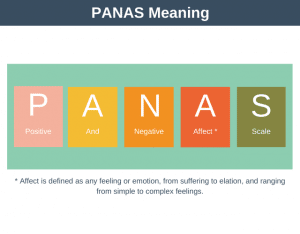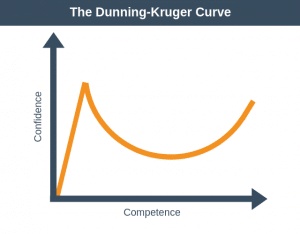The premise of Atomic Habits by James Clear is that it’s very easy to underestimate the value of making small improvements on a daily basis. Too often we convince ourselves that massive success requires massive action.
Why should we try to get a little better each day? Well, take a look at the following amazing maths.

If you can get 1% better each day over the next year, you’ll be 37 times better by the time you’re done. This applies to all goals, whether it is losing weight, winning a race, or starting a business.
Small habits can compound over time. In fact, according to Atomic Habits, habits are the compound interest of self-improvement. The same way that money multiplies through compound interest, the effect of your habits multiplies as you repeat them. They seem to make little or even no difference on any given day but the impact they deliver over the months and years can be enormous.
What are Atomic Habits?
You’ve probably already worked it out, but Atomic Habits are small tiny habits. Just like atoms, they are small but they have the ability to be mighty. Atomic habits become mighty when they are repeated hundreds or even thousands of times.
Bad habits compound too. Putting off a project to tomorrow seems to make no difference. But when you repeat this type of 1% error day after day, these tiny errors can compound into toxic results.
Success is the product of daily habits. Not once-in-a-lifetime transformations. But be aware that your outcomes will lag behind your habits. For example, your wealth is a lagging measure of your saving habits. Because of the lag factor, you should be far more concerned with your current trajectory than with your current results.
The hallmark of any compound process is that the most powerful outcomes are delayed. Habits appear to make no difference until we cross a threshold and unlock a new level of performance.
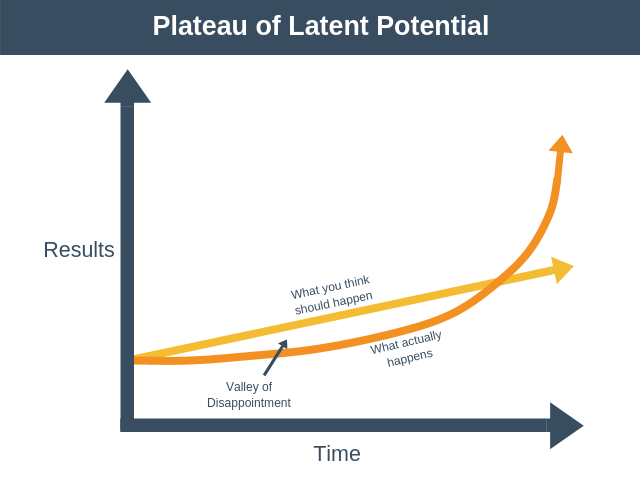
This is one of the reasons why it’s hard to build habits. You make a change, fail to see a tangible result and decide to give up. Habits need to persist long enough to break through the Plateau of Latent Potential (see above diagram). This takes time.
If your complaining about progress early on remember: You effort hasn’t been wasted, it’s being stored up. It’s just that you haven’t broken through the plateau yet. When suddenly you do break through, people will think you’re an overnight success.
Forget About Goals. Concentrate on Systems
Goals are about the results you want to achieve. Systems are about the processes that lead to those results.
Atomic Habits states that if you focus on the system the goal will take care of itself. There are a number of reasons why you should focus on the system.
1. Because winners and losers have the same goals.
Every Olympian wants to win a gold medal. Every entrepreneur wants to be successful. Thus, its the systems of winners that get them better results, not their goals.
2. Achieving a goal is only a momentary change.
If our goal is to tidy a room and we tidy it, then we hit our goal. But without changing our system we’ll soon be looking at a messy room again.
3. Goals restrict your happiness.
Our implicit assumption is: “Once I reach my goal, then I’ll be happy.” This sets us up to fail. Because either you achieve your goal and then look for the next goal, or you fail and this makes you feel unhappy. We should be looking to fall in love with the process, not the goal.
4. Goals are at odds with long-term progress.
Many people will train hard to complete a marathon. But when the marathon is over they completely stop running. The goal of running the marathon was their motivation but now it’s gone.
Key Takeaway
If you’re having trouble changing your habits the problem isn’t you. The problem is your system. Focusing on the overall system, rather than a single goal, is one of the core themes of Atomic Habits. You do not rise to the level of your goals. You fall to the level of your system.
The Three Layers of Behavior Change
The Three Layers of Behavior Change are shown in the diagram below.

You can think of outcomes being about what you get. Processes are about what you do. Identity is about what you believe.
Most people don’t even consider identity change when they set out to improve. They just think, “I want to be skinny (outcome) and if I stick to this diet, then I’ll be skinny (process).”
They set goals and determine the actions they should take to achieve those goals without taking into account the beliefs that drive their actions. They don’t realize that their old identity can sabotage their plans for change.
For example. You may want better health. But if you continue to prioritize comfort over accomplishment, you’ll be drawn to relaxing rather than training. It’s hard to change your habits if you don’t change your underlying beliefs that lead to your previous bad behavior.
True behavior change is identity change. You might start a habit because of motivation, but the only reason you stick with one is that it becomes part of your identity.
You’re much more likely to work out each day if you believe you’re an athlete. You don’t have to force anything. You’re simply acting like the type of person you believe yourself to be.
The biggest barrier to positive change is identity conflict. Good habits can make sense rationally, but if they conflict with your identity you will fail to maintain them.
Your identity is formed through evidence. If you run even when it’s snowing you have evidence you’re a runner. But it doesn’t happen with just one run. It is a gradual process that may take years.
Every action you take is a vote for the type of person you wish to become. No single instance will transform your beliefs, but as the votes build up, so does the evidence of your new identity.
Here is a two-step process for change:
- Decide the type of person you want to be.
- Prove it to yourself with small wins (atomic habits).
This will set up a feedback loop: Your habits shape your identity, but then your identity shapes your habits.
The fundamental thing to remember with atomic habits is that they are not about having something. They are about becoming someone.
The Habit Loop
Atomic Habits states that habits follow this cycle: cue, craving, response, reward.
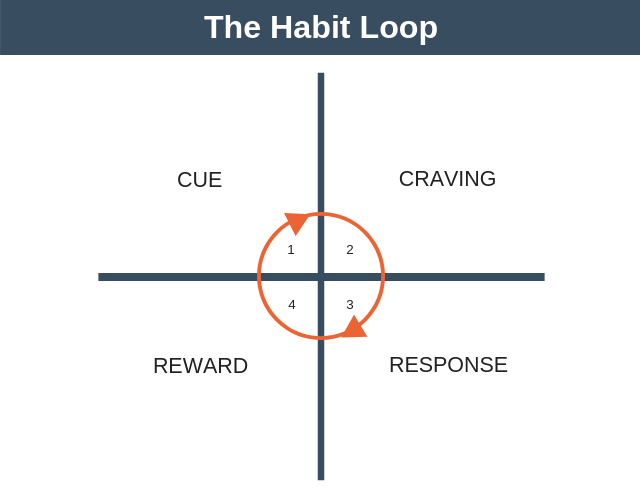
First, there is the cue. The cue triggers your brain to initiate a behavior because it predicts a reward. Next, we have the craving. What you crave is not the habit itself, but the change in state it delivers. The response is the actual habit you perform. This can be a thought or an action. Finally, the response delivers a reward.
The four steps together form a neurological feedback loop: cue, craving, response, reward, cue, craving, response, reward – that ultimately allow you to create automatic habits. This is the habit loop.
The Four Laws of Behavior Change
Atomic Habits provides a framework we can use to transform the four steps of the Habit Loop so that we can design good habits and eliminate bad ones.
| Step | Designing Good Habits | Breaking Bad Habits |
|---|---|---|
| Cue | Make it obvious | Make it invisible |
| Craving | Make it attractive | Make it unattractive |
| Response | Make it easy | Make it difficult |
| Reward | Make it satisfying | Make it unsatisfying |
Note that that method of breaking a bad habit is always the opposite of building a good one.
Whenever you want to change your behavior, simply ask yourself:
- How can I make it obvious?
- How can I make it attractive?
- How can I make it easy?
- How can I make it satisfying?
Let’s examine each law in detail. In each section, we’ll look at multiple ways to boost your good habits and finish with an inversion showing how to break your bad habits.
The 1st Law: Make It Obvious
Before we can build new habits we need to understand our current ones. This can be harder than it sounds because once you have a deeply rooted habit it can be unconscious and automatic.
To become aware of your habits, use a Habits Scorecard. To create your own, simply make a list of your daily habits:
- Wake up =
- Check phone –
- Go to the bathroom +
- Weigh myself +
- Have breakfast +
- etc.
Once you have a complete list, score each of them. Use “+” for good habits, “-” for bad, and “=” for neutral.
When scoring your habits think about how the habit will benefit you long term. For example, drinking wine might reduce your stress right now (that’s how it’s serving you), but it’s not a healthy long-term habit.
Note the goal is simply to notice your habits. We’re not trying to change anything yet.
If you’re struggling to notice your habits you can use a technique called Pointing-and-Calling to raise your awareness by verbalizing your actions. For example, if you’re about to eat a cookie, say “I’m about to eat a cookie. This is bad for my long-term health”. It will really help you realize what you’re doing.
1. The Best Way to Start a New Habit
Is to use implementation intentions. Their format is:
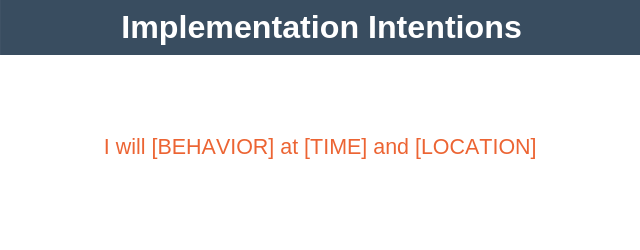
Hundreds of studies have shown implementation intentions help people stick to their plans. People who make a plan for when and where they will perform a new habit are more likely to follow through.
They work because they turn vague promises into hard promises. For example, “I want to work out more”, becomes, “I’m going to the gym every Tuesday and Thursday before going to work.”
2. Habit Stacking
According to Atomic Habits, one of the best ways to build a new habit is to identify an existing habit and then stack a new behavior on top. This is called habit stacking.
Examples:
- After I shower in the morning I will meditate.
- As soon as I take off my shoes after work I will spend 30 minutes learning French.
Once you begin to master how to do this, you can create larger stacks by chaining atomic habits together.
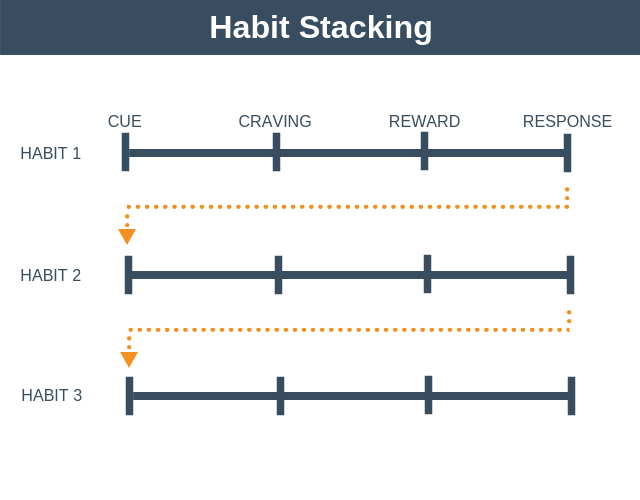
The secret to habit stacking is selecting the right cue to kick things off. Habit stacking works best when the cue is highly specific and immediately actionable.
3. Environment Matters More than Motivation
If you work at an office that always has donuts in the kitchen then the chances are you’ll eat one from time to time. In this case your environment will have influenced your behavior.
In fact, the environment is the invisible hand that shapes our behavior.
Environment design means altering the spaces where you live and work to increase your exposure to positive cues and reduce your exposure to negative ones. Environment design can be powerful because not only because it influences how we engage with the world but also because we rarely do it.
Inversion: The Secret to Self-Control
Bad habits are autocatalytic. They feed themselves. They promote the feelings they try to numb. You feel bad, so you eat junk food. Because you’ve eaten junk food you feel bad.
The idea that self-discipline can solve our bad habits is deeply embedded in our culture.
Research, however, shows something different. It shows that “disciplined” people are better at structuring their lives in such a way that it doesn’t require heroic willpower and self-control. Basically, they spend less time in tempting situations.
A practical way to remove a bad habit is to reduce exposure to the cue that causes it. For example, if you regularly feel like you’re not enough, stop using social media that triggers jealousy.
This practice is an inversion of the 1st Law of Behavior Change. Rather than make it obvious, we want to make it invisible. Self-control is a short-term strategy, not a long-term one.
The 2nd Law: Make it Attractive
1. Temptation Bundling
Temptation bundling is a way to create a more desirable version of a habit by connecting it with something you already want.
Engineering a really irresistible habit is a difficult thing to do, but temptation bundling can be used to make most habits more attractive than they would be otherwise.
Temptation bundling basically says that you’re more likely to find a behavior attractive if you get to do one of your favorite things at the same time. For example, you want to know celebrity gossip, but you need to get in shape. Using temptation bundling, you could only read gossip magazines at the gym.
Temptation bundling can be used in conjunction with habit stacking to create a set of rules to guide your behavior. The formula is:

For example, if you want to watch sports but you need to make sales calls.
- After I get back from lunch break, I will call three potential clients (need).
- After I call three potential clients, I will check ESPN (want).
The hope is that eventually, you look forward to calling three clients each day.
2. The Seductive Pull of Social Norms
Humans are herd animals. We want to fit in. One of the deepest human desires is to belong.
Social norms are invisible rules that guide your behavior. You’re always keeping them in mind, even when they are not at the top of your mind. For example, social norms tell us when and whether to get married and how many children to have.
We imitate the habits of three groups: the close, the many, and the powerful.
a. Imitating the Close
Our friends and family provide a kind of invisible peer pressure that pulls us in their direction.
To build better habits join a culture where your desired behavior is the normal behavior. New habits seem achievable when you see others doing them every day.
Nothing sustains motivation better than belonging to a tribe.
One of the best things you can do to build better habits is to join a culture where:
- Your desired behavior is the normal behavior.
- You already have something in common with this group.
b. Imitating the Many
Whenever we are unsure how to act, we look to the group to guide our behavior. We are constantly scanning our environment to see what everyone else is doing. We check the reviews on Amazon because we want to make the right buying decision. We check TripAdvisor reviews because we want to make the best travel decision.
c. Imitating the Powerful
Humans everywhere pursue power, prestige, and status. If a behavior can get us these things then we find it attractive.
Inversion: Find an Fix the Causes of Your Bad Habits
Your bad habits are modern solutions to ancient desires. New versions of old vices. The underlying motives behind the way you behave remains the same. For example:
- If your underlying motive is to find love your habit might be using Tinder.
- If your underlying motive is to achieve social acceptance your habit might be posting on Instagram.
Why is this important? Because there are many different ways to address the same underlying motive. You might reduce your stress by going for a run, or you might reduce your stress by smoking a cigarette.
Your current habits are not necessarily the best way to solve your problems. They are just the methods you’ve learned to use.
When you binge eat, what you really want isn’t a potato chip. You want to change the way you feel.
The cravings you experience and then the habits you perform are an attempt to address underlying motives. When a habit is successful in addressing a motive, you develop a craving to do it again. In time you learn to predict that checking Instagram will make you feel accepted.
A simple way to make a bad habit seem unattractive is to try and find a better way of meeting your underlying motive. So if you eat because you want to feel better, maybe next time you want to feel better you could try going for a run.
The 3rd Law: Make it Easy
It’s easy to get bogged down trying to find the optimal plan for change. Often we get so focused on figuring out the best approach that we forget to take action.
1. Motion vs. Action
When you’re in motion you’re planning and strategizing. This is different from actually taking action. It is only action that can directly lead to actual results.
But if motion doesn’t lead to results why do we do it? Well, sometimes we need to plan and learn. However, more often than not, motion allows us to feel as though we’re making progress without running the risk of failure. Motion makes us feel like we’re getting things done. But actually, you’re just preparing to get something done.
If you want to build a habit you need repetition, not perfection. You need action.
So, how long does it take to form a habit? That’s the wrong question. The real question should be how many reps does it take to form a habit. Because habits are based on frequency, not time.
Your current habits have been internalized over hundreds or even thousands of repetitions. New habits will require the same level of frequency.

To build a habit, you need to practice it. The most effective way to make the practice happen is to adhere to the 3rd Law of Behavior Change: make it easy.
2. The Law of Least Effort
Conventional wisdom holds that motivation is the key to change a habit. If we just want it enough then we will change. But the truth is that human behavior follows the Law of Least Effort. We naturally gravitate toward the option that requires the least amount of work.
We can use this to our advantage by creating an environment where doing the right thing is as easy as possible. Do this by:
a. Reducing Friction
Reduce the friction associated with good behaviors. Example:
- If you want to get fit you could join a gym that is on your route to work. This removes the friction of having to go out of your way to get to a gym. You could also get your gym kit organized and ready the night before.
b. Increasing friction
Increase the friction associated with bad behaviors. Example:
- If you want to watch less television only turn on the TV after you say out loud the name of the programme you want to watch. This will stop thoughtless viewing.
3. The Two-Minute Rule
Atomic habits might just take a short moment to complete, but they can continue to impact your behavior for hours afterward.
The Two-Minute Rule utilizes this fact by stating, “When you start a new habit, it should take less than two minutes to do”.
The two-minute rule should help make it easier to build a new habit. For example:
- Want to read more? Read a page a day.
- Want to write more? Write a sentence per day.
There are two reasons the two-minute rule works:
- It is a “gateway habit” that naturally leads you down a more productive path.
- It reinforces the identity you want to build. If you show up at the gym 7 days a week, even if it’s just for 5 minutes you’re becoming the type of person who doesn’t miss workouts.
A key point is to get started. You can worry about improving your atomic habit later. But you can’t improve a habit that doesn’t exist.
Inversion: Making Bad Habits Impossible
By utilizing commitment devices, strategic one-time decisions, and technology you can create an environment of inevitability. A place where good habits are not just something you hope for, but something virtually guaranteed.
a. Commitment Device
Sometimes success is less about making good habits easy and more about making bad habits hard. One way to do this is by using something called a commitment device. This is a choice you make in the present to control your actions in the future.
A commitment device makes bad habits impractical to do. They increase the friction until you don’t even have the option to act.
For example, the average person spends two hours per day on social media. Would you like an extra 600 hours per year? Ask your partner to change your social media passwords every Monday morning, and only give them back to you on a Friday. You’ll be surprised how much extra time you gain during each week.
b. Strategic Onetime Decisions
These are things you only have to do once that keep on giving and giving. For example, if you want to improve the quality of your sleep you could buy a blackout blind. If you wanted to improve your mental health then you could get a dog.
c. Use Technology
This is especially useful when atomic habits aren’t something you do every day. For example, you could use an App to automate your saving each month or to automate your bill paying every month.
The 4th Law: Make it Satisfying
It’s important to make your atomic habits satisfying because you’re more likely to repeat behavior when you find the experience satisfying.
As humans, it can be hard to pick up new habits. This is because the beginning of a new habit is mostly sacrificing without reward. You go to the gym a few times and nothing changes. It takes months to see real results.
This difficulty is compounded because the human brain has evolved to prioritize immediate rewards over delayed rewards.
So if you want to get a habit to stick, you need to figure out a way to give yourself an immediate reward.
One technique you can use when the reward is long-term is to set up a loyalty system for yourself. For example, imagine you want to give up alcohol. On its own there is no satisfaction is simply abstaining. But what if you transferred $25 to your holiday bank account every week you went without alcohol. You’d be immediately rewarding yourself for your new habit.
Eventually, the intrinsic reward such better moods and more energy kick in, and you’ll no longer need the reward as your identity will be changing. You’ll be becoming a non-drinker.
While the first three laws of behavior change: make it obvious, attractive, and easy, increase the odds that a behavior will be performed. The fourth law, make it satisfying, increases the odds that a behavior will be repeated.
1. How to Stick to Habits
To track your atomic habits use a habit tracker. Why? Because:
- They create a visual cue that reminds you to act.
- They’re motivating because you see the progress you’re making and don’t want the streak to stop.
- It’s satisfying to put another X on your tracker.
- They provide visual proof that you’re casting votes for the type of person you want to become.
Things go wrong and from time to time you will break your streak. When this happens try to get a new streak started as quickly as possible.
Missing once is an accident. Missing twice is the start of a new habit. This is the difference between winners and losers. Anyone can perform badly once. But when successful people fail, they rebound quickly.
Inversion: Habit Contracts and Accountability Partners
The inversion of the fourth law is to make it unsatisfying. We are less likely to repeat a bad habit if it is painful and unsatisfying in the moment.
One way to do this is to create an immediate consequence using a habit contract. These make the cost of violating your promises public and painful. For example, every time you eat junk you will post on Facebook saying you’ve been unhealthy and offer $20 via PayPal to the first person to respond.
An accountability partner can help with this too. Accountability partners work because we care about what others think about us, and we don’t want them to have a poor opinion of us. The fact we know someone is watching can have a large impact on our behavior.
ADVANCED TACTICS
1. The Truth About Talent
Genes don’t remove the need for hard work. They tell us what to work hard on.
Basically, try to play a game that favors your strengths. If you can’t find a game that favors you, create one.
2. The Goldilocks Rule
Once an atomic habit has been formed it’s important to continue to advance in small ways. These small improvements keep you motivated. This is referred to as the Goldilocks Zone.

The greatest threat to success is not failure but boredom. We get bored with a new habit because we’re performing it every day and not seeing results. Realize that successful people feel the same lack of motivation as everyone else. The difference is that they still find a way to show up.
3. Gaining Mastery
The process of mastery through atomic habits looks something like this:

Precisely at the moment when you begin to feel like you’ve mastered a skill, you must avoid complacency so you progress to the next level. The solution? Establish a system for reflection and review. This will enable you to objectively see what’s working and what isn’t, and based on this make better plans going forward.
Atomic Habits Summary
Atomic Habits are small habits that can have a huge impact if performed over months or years. The goal isn’t to make a single 1% improvement, but to make thousands of them. It’s lots of atomic habits stacking up, each one part of a system, that eventually creates a huge impact.
At the start, small improvements often seem meaningless even if you logically know they are the right thing to do. Gradually, though, as you continue to stack small changes on top of one another the scales start to tip in your favor. Eventually, if you stick with it you hit a tipping point. Suddenly, it’s easier to stick with good habits and the overall system is working for you.
Although there is nothing new in Atomic Habits, I found it pulled lots of different ideas together in a really cohesive way. I also found the 4 Laws of Behavior Change simple to remember and easy to implement. On the downside, sometimes I felt sections were written without having any actionable steps at the end of them and I was left wondering how to implement what I’d just read.
But, overall, a great book, and I give Atomic Habits by James Clear it a really solid 9 out of 10.

